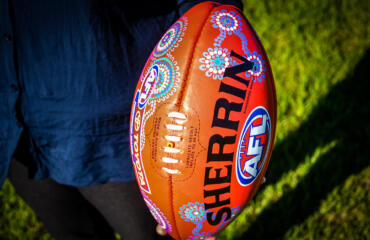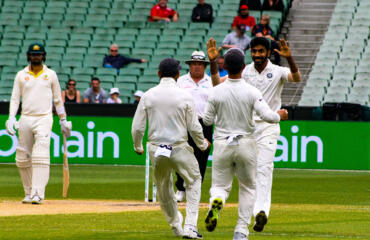As horses and fashionistas gather at the course in Flemington tomorrow for “the race that stops a nation”, another collection of competitors will be in the starting gates just a stone’s throw away at a local park.
“Fashuns on the Field” – a protest-party entering its sixth year – pits human against human in the Crawfield Cup (where participants crawl), and the underwater-themed Melbourne Carp. With the decidedly unglamorous underbelly of the racing industry now in the public gaze, event organisers are expecting a record turnout at the Kensington Reserve.

The protest is the brainchild of Melbourne artist Teneille Clerke, and a part of a broader movement of nationwide “Nup to the Cup” events co-organised by the Coalition for the Protection of Racehorses.
Their concerns about the welfare of the animals that are the engines of the $9 billion Australian racing industry have gained wide traction as the industry undergoes a public reckoning in the wake of a series of high-profile scandals, the most sensational of which emerged on the eve of the season-opening Caulfield Cup. The ABC’s 7.30 program aired gruesome footage of ex-racehorses being electric shocked, kicked, dragged and slaughtered at Queensland’s Merrimist abattoir.
In an impassioned op-ed on radio in the days that followed the program, leading Melbourne sports broadcaster Gerard Whateley – a racing aficionado, and champion Black Caviar’s biographer – said that protestors have never been more relevant, and are no longer simply “howling at the moon while everyone else is having a great time”.
The risk for racing, he said, was that it would “drift so far outside modern community standards, which are shifting, as to no longer be acceptable”.
For University of Sydney Urban and Environmental Geography Professor Phil McManus – an expert in animal-human relations – debate about whether the racing industry still has a social license to operate isn’t new. He explored this question in an article for The Conversation in 2017, and says that the 7.30 Report revelations have put the issue firmly back in mainstream frame.
McManus says the new revelations – around 4000 horses killed at one Queensland abattoir alone in the space of year, according to the Coalition for the Protection of Racehorses – are especially damning when you consider how much detail is demanded in the monitoring horses as they enter the racing industry.
“There’s a lot of effort that goes into ensuring that when the horse enters the industry, and when it’s registered, that it’s born from a registered stallion and a registered thoroughbred mare, that are both from the Stud Book,” he says. Further, he explains, breeders can’t use artificial insemination, or embryo transfer.
“At the other end of the picture, if I owned a horse, for example, and I decided it’s no longer going to win any races, I can’t be bothered looking after it, the trainer just fills in a registration form saying the horse has moved off to a farm and it’s happily grazing there.
“Legally, they [racing authorities] could argue they don’t have responsibility once it [the horse] leaves the industry.
“I think people are saying that’s nowhere near good enough. I think there’s definitely a rising tide about that idea.”
Clerke and the Coalition for the Protection of Racehorses are seeing plenty of evidence that this is indeed the case.

Revellers prepare to race at the first “Fashuns” event six years ago.
“Based on interactions with the event on Facebook, it’s already surpassed what the whole of the event got last year,” Clerke says. More than 400 people are listed as “going” to the event on Facebook, with another 1,300 listed as “interested”, numbers that Clerke says are matched by a spike in media requests.
Kristin Leigh, a spokesperson for the coalition, says that the on-track euthanasia of 2018 Melbourne Cup runner The Cliffsofmoher – the sixth horse to die in the cup since 2013 – meant people were already paying attention. But even within her organisation – which advocates against the use of the whip, tongue-tying and a range of other racing practises – the 7.30 Report was a game changer.
“We’ve always welcomed welfare improvements, but we’ve always thought that the industry is inherently cruel. It’s only really now that we are absolutely 100% convinced that it is beyond redemption,” Leigh says.
While Clerke says a lot of the social media engagement around her event is from women aged 25 – 36, there are usually plenty of people outside that demographic who turn up on the day and say, “this is great, I want to be a part of it”.
Professor McManus says “it’s too early to tell” what the overall impact of the 7.30 report will be, but he’s confident “there’s definitely been some change.
“When you have people like [racing caller] Bruce McAvaney on television saying that ‘this is shameful, we need immediate action’, and other trainers – Lee Freedman, Chris Waller – famous trainers, calling for strong action, it isn’t just the people who never liked horse racing to begin with.
“I think there’s perhaps a lot of people in the middle ground area who [previously] thought, ‘it’s okay, I don’t mind it. I don’t really have too much to think about’. Now, suddenly, they’re awoken by those images.”
It’s not just the hands-on racing diehards making noise. Popular socialite and model Megan Gale – usually a star attraction in the Birdcage during the Spring Carnival – is a late scratching, a decision she “did not make lightly”, according to a statement she put out last week. Last month, superstar US singer Taylor Swift withdrew from her planned performance at the event after a fierce backlash from her fan base, citing scheduling issues.
Given the visibility and youth appeal of the figures shunning the Cup, it’s easy to see why several commentators, including McAvaney and Whateley, have questioned whether racing can continue to appeal to younger generations.
Research suggests their fears are well-founded. A 2016 study found that the average age of horse racing fans across the globe is 63, and there’s also strong evidence that millennials and centennials (Gen Z) prefer brands that promote progressive values. Global research in 2019 by music streaming behemoth Spotify found that 66% of centennials and millennials “think brands need to promote progressive values and play a more meaningful role in society”.
The aggregate attendance at the four major Flemington Cup Week race days has been on the wane since peaking at 418,096 in 2006. In 2018, 303,587 turned out, the lowest crowd since 1999.
That said, racing’s roots run deep. According to McManus, the industry in Australia is inherently different from racing elsewhere. This country has a lot more country race tracks than the UK, France, Germany and America, and that means the sport holds a unique position in terms of social identity and local economies. It also changes dynamics when it comes to considering the industry’s resilience in the long term.
A national registry of retired racehorses, which advocates say would save horses from the knackery, would go “someway to restoring a social license or social mandate,” says McManus. He also notes that Racing Victoria’s newly announced $25 million fund for horse welfare over the next three years “will go some way to showing that they’re making a commitment”.
Perhaps the only thing that’s certain is that the debate is going to rage on.
“Unless the horse racing industry does evolve and change pretty significantly, in order to align themselves more closely with the changing values around the use of animals for entertainment, I can see the fracture growing,” McManus says.




